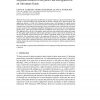93 search results - page 10 / 19 » Learning action models for multi-agent planning |
UMUAI
1998
13 years 7 months ago
1998
We present an approach to keyhole plan recognition which uses a dynamic belief (Bayesian) network to represent features of the domain that are needed to identify users’ plans and...
TBILLC
2005
Springer
14 years 29 days ago
2005
Springer
Abstract. Applying multi-agent systems in real world scenarios requires several essential research questions to be answered. Agents have to perceive their environment in order to t...
UAI
2008
13 years 9 months ago
2008
Model-based Bayesian reinforcement learning has generated significant interest in the AI community as it provides an elegant solution to the optimal exploration-exploitation trade...
AIPS
2011
12 years 11 months ago
2011
Engineering complete planning domain descriptions is often very costly because of human error or lack of domain knowledge. Learning complete domain descriptions is also very chall...
ICRA
2007
IEEE
14 years 1 months ago
2007
IEEE
— One of the most notable and recognizable features of robot motion is the abrupt transitions between actions in action sequences. In contrast, humans and animals perform sequenc...

